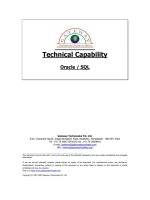Tài liệu Wireless Networks doc
Bạn đang xem bản rút gọn của tài liệu. Xem và tải ngay bản đầy đủ của tài liệu tại đây (401.69 KB, 47 trang )
Wireless Networks
Authors:
Marius Popovici
Daniel Crişan
Zagham Abbas
Cluj-Napoca, 24 Nov. 2003
Technical University of
Cluj-Napoca
Group 3250
Presentation Outline
•
Wireless Technology overview
•
The IEEE 802.11 WLAN Standards
•
Secure Wireless LANs
•
Migrating to Wireless LANs (Cutting the cord)
Wireless?
•
A wireless LAN or WLAN is a wireless local area network
that uses radio waves as its carrier.
•
The last link with the users is wireless, to give a
network connection to all users in a building or campus.
•
The backbone network usually uses cables
Common Topologies
The wireless LAN connects to a wired LAN
•
There is a need of an access point that bridges wireless LAN traffic
into the wired LAN.
•
The access point (AP) can also act as a repeater for wireless nodes,
effectively doubling the maximum possible distance between nodes.
Common Topologies
Complete Wireless Networks
•
The physical size of the network is determined by the maximum
reliable propagation range of the radio signals.
•
Referred to as ad hoc networks
•
Are self-organizing networks without any centralized control
•
Suited for temporary situations such as meetings and conferences.
How do wireless LANs work?
Wireless LANs operate in almost the same way as
wired LANs, using the same networking protocols
and supporting the most of the same
applications.
How are WLANs Different?
•
They use specialized physical and data link
protocols
•
They integrate into existing networks through
access points which provide a bridging function
•
They let you stay connected as you roam from
one coverage area to another
•
They have unique security considerations
•
They have specific interoperability requirements
•
They require different hardware
•
They offer performance that differs from wired
LANs.
Physical and Data Link Layers
Physical Layer:
•
The wireless NIC takes frames of data from the link
layer, scrambles the data in a predetermined way, then
uses the modified data stream to modulate a radio
carrier signal.
Data Link Layer:
•
Uses Carriers-Sense-Multiple-Access with Collision
Avoidance (CSMA/CA).
Integration With Existing Networks
•
Wireless Access Points (APs) - a small device that
bridges wireless traffic to your network.
•
Most access points bridge wireless LANs into Ethernet
networks, but Token-Ring options are available as well.
Integration With Existing Networks
Roaming
•
Users maintain a continuous connection as they
roam from one physical area to another
•
Mobile nodes automatically register with the
new access point.
•
Methods: DHCP, Mobile IP
•
IEEE 802.11 standard does not
address roaming, you may need
to purchase equipment from one
vendor if your users need to roam
from one access point to another.
Security
•
In theory, spread spectrum radio signals are inherently
difficult to decipher without knowing the exact hopping
sequences or direct sequence codes used
•
The IEEE 802.11 standard specifies optional security
called "Wired Equivalent Privacy" whose goal is that a
wireless LAN offer privacy equivalent to that offered by
a wired LAN. The standard also specifies optional
authentication measures.
Interoperability
•
Before the IEEE 802.11 interoperability was
based on cooperation between vendors.
•
IEEE 802.11 only standardizes the physical and
medium access control layers.
•
Vendors must still work with each other to ensure
their IEEE 802.11 implementations interoperate
•
Wireless Ethernet Compatibility Alliance (WECA)
introduces the Wi-Fi Certification to ensure cross-
vendor interoperability of 802.11b solutions
Hardware
•
PC Card, either with integral antenna or with external
antenna/RF module.
•
ISA Card with external antenna connected by cable.
•
Handheld terminals
•
Access points
Hardware
CISCO Aironet 350 series Wireless Handheld Terminal
Semi Parabolic Antenna
BreezeCOM AP
Performance
•
802.11a offers speeds with a theoretically maximum
rate of 54Mbps in the 5 GHz band
•
802.11b offers speeds with a theoretically maximum
rate of 11Mbps at in the 2.4 GHz spectrum band
•
802.11g is a new standard for data rates of up to a
theoretical maximum of 54 Mbps at 2.4 GHz.
What is 802.11?
•
A family of wireless LAN (WLAN) specifications
developed by a working group at the Institute
of Electrical and Electronic Engineers (IEEE)
•
Defines standard for WLANs using the following
four technologies
•
Frequency Hopping Spread Spectrum (FHSS)
•
Direct Sequence Spread Spectrum (DSSS)
•
Infrared (IR)
•
Orthogonal Frequency Division Multiplexing (OFDM)
•
Versions: 802.11a, 802.11b, 802.11g, 802.11e,
802.11f, 802.11i
802.11 - Transmission
•
Most wireless LAN products operate in unlicensed radio
bands
•
2.4 GHz is most popular
•
Available in most parts of the world
•
No need for user licensing
•
Most wireless LANs use spread-spectrum radio
•
Resistant to interference, secure
•
Two popular methods
•
Frequency Hopping (FH)
•
Direct Sequence (DS)
Frequency Hopping Vs. Direct Sequence
•
FH systems use a radio carrier that “hops” from
frequency to frequency in a pattern known to both
transmitter and receiver
•
Easy to implement
•
Resistance to noise
•
Limited throughput (2-3 Mbps @ 2.4 GHz)
•
DS systems use a carrier that remains fixed to a specific
frequency band. The data signal is spread onto a much
larger range of frequencies (at a much lower power
level) using a specific encoding scheme.
•
Much higher throughput than FH (11 Mbps)
•
Better range
•
Less resistant to noise (made up for by redundancy – it transmits at least
10 fully redundant copies of the original signal at the same time)
802.11a
•
Employs Orthogonal Frequency Division Multiplexing
(OFDM)
•
Offers higher bandwidth than that of 802.11b, DSSS
(Direct Sequence Spread Spectrum)
•
802.11a MAC (Media Access Control) is same as
802.11b
•
Operates in the 5 GHz range
802.11a Advantages
•
Ultra-high spectrum efficiency
•
5 GHz band is 300 MHz (vs. 83.5 MHz @ 2.4 GHz)
•
More data can travel over a smaller amount of
bandwidth
•
High speed
•
Up to 54 Mbps
•
Less interference
•
Fewer products using the frequency
•
2.4 GHz band shared by cordless phones, microwave
ovens, Bluetooth, and WLANs
802.11a Disadvantages
•
Standards and Interoperability
•
Standard not accepted worldwide
•
No interoperability certification available
for 802.11a products
•
Not compatible or interoperable with 802.11b
•
Legal issues
•
License-free spectrum in 5 GHz band not
available worldwide
•
Market
•
Beyond LAN-LAN bridging, there is limited interest for
5 GHz adoption
802.11a Disadvantages
•
Cost
•
2.4 GHz will still has >40% cost advantage
•
Range
•
At equivalent power, 5 GHz range will be ~50% of
2.4 GHz
•
Power consumption
•
Higher data rates and increased signal require more
power
•
OFDM is less power-efficient then DSSS
802.11a Applications
•
Building-to-building connections
•
Video, audio conferencing/streaming video,
and audio
•
Large file transfers, such as engineering
CAD drawings
•
Faster Web access and browsing
•
High worker density or high throughput
scenarios
•
Numerous PCs running graphics-intensive applications
802.11a Vs. 802.11b
802.11a vs.
802.11b
802.11a 802.11b
Raw data rates
Up to 54 Mbps
(54, 48, 36, 24,18, 12
and 6 Mbps)
Up to 11 Mbps
(11, 5.5, 2, and
1 Mbps)
Range
50 Meters 100 Meters
Bandwidth
UNII and ISM
(5 GHz range)
ISM (2.4000—
2.4835 GHz range)
Modulation
OFDM technology DSSS technology









